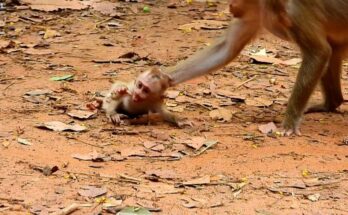In the intricate and emotional world of primate parenting, there comes a moment that marks a powerful shift in the bond between mother and child: the weaning process. For one young monkey, that moment has begun. Her mother, once endlessly attentive—nursing her, grooming her, and carrying her day and night—has started to pull away. The change is subtle but firm. The baby now must begin to face the world on her own, learning independence not through comfort, but through challenge.
Weaning in monkeys is a natural but often emotional process. It typically begins when the infant reaches a few months of age, depending on the species. In this case, the young monkey, likely a vervet or macaque, has reached the age where milk is no longer enough, and she must begin eating solid foods and developing social skills necessary for survival. Her mother, responding to instinct and biological cues, has started to deny her frequent access to nursing. Instead of constantly carrying her baby, she now walks ahead, turning back occasionally to see if her child is following. She is not abandoning her—but she is letting go, slowly and deliberately.
The baby doesn’t understand this at first. She still reaches for her mother, squeaking softly, trying to nurse or be picked up. Sometimes, her mother relents briefly. Other times, she pushes the infant away gently but firmly, encouraging her to stand on her own feet—literally and figuratively. The baby, confused and a little frightened, begins to explore the nearby branches hesitantly, often looking back toward her mother for reassurance.
This transition is a critical milestone. The baby must learn to forage, recognize social cues, and navigate the troop’s complex dynamics. These early lessons in independence will determine her ability to survive and thrive. Though difficult to watch, the process is necessary. In the wild, over-dependence on a mother can leave an individual vulnerable in a world where quick reactions and confidence are vital.

Observers of this mother-infant pair have noted the emotional tension in the interactions. The baby still tries to climb onto her mother’s back, and when she fails, she sometimes lets out loud cries of frustration. The mother watches closely, never straying too far, but she no longer steps in immediately. Her restraint is not cruelty—it’s teaching. By allowing her baby to stumble, she is letting her learn balance. By letting her cry, she is letting her find her voice.
Eventually, the baby will gain confidence. She’ll play more with other juveniles, pick up bits of fruit on her own, and spend longer stretches away from her mother. One day, she won’t try to nurse anymore. She’ll have learned that she is capable of more than she realized.
This quiet moment in the trees—a mother stepping back so her baby can step forward—reflects the universal struggle of growing up. It’s painful, necessary, and beautiful. In the end, letting go becomes an act of love.
